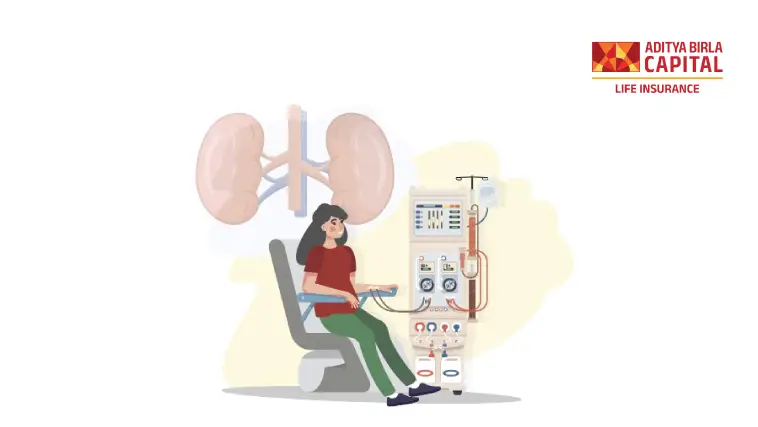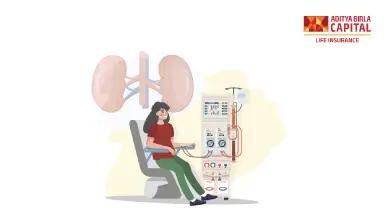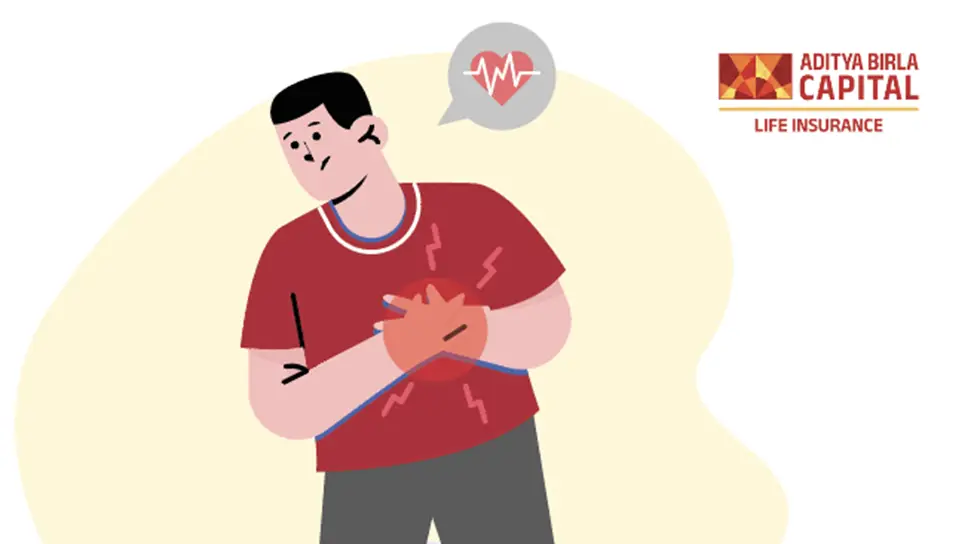Aditya Birla Sun Life Insurance Company Limited
Dialysis - How it Works and Types?

Plan Smarter, Live Better!

Thank you for your details. We will reach out to you shortly.

Currently we are facing some issue. Please try after sometime.


- Table of Contents
In today's fast-paced world, our health is a precious treasure we often take for granted. Amid the hustle and bustle of modern life, diseases have silently crept into our lives - posing a grave danger to our well-being. Among these health concerns, kidney diseases have become a major cause for worry, affecting numerous lives across the globe. According to recent reports published by The Indian Express, over 7.8 million individuals in India are currently living with chronic kidney diseases.1 This alarming statistic shows the magnitude of the kidney health crisis that has gripped the nation. However, in the face of this growing health crisis, there is a solution that provides hope and a lifeline to those battling kidney ailments - Dialysis. It is a treatment option that acts as a surrogate kidney, doing its job of filtering out toxins and waste from your blood when your natural organ can no longer perform this task. With kidney diseases taking a toll on individuals and communities, it becomes crucial to understand the ins and outs of dialysis and its different types. So, let's delve deeper into dialysis, how dialysis works, its types, the risk associated with dialysis, and more.
What is Dialysis?
Dialysis is a medical procedure that provides support to individuals who face kidney failure or weakened kidney function. Your kidneys hold a vital responsibility in filtering out waste, excess fluids, and toxins from your bloodstream. Additionally, they help maintain the proper balance of electrolytes and control fluid levels in our bodies. But when the kidneys encounter impairment or fail to perform their duties, harmful substances start to accumulate in the blood. However, dialysis proves a lifesaving solution by stepping in to maintain electrolyte balance, eliminate waste products, manage fluid levels, and ease the burden on compromised kidneys. This procedure helps in alleviating symptoms and complications that often accompany kidney failure, like fatigue, fluid overload, high blood pressure, irregular electrolyte levels, etc. Through dialysis, individuals gain a better chance at improved health despite the challenges.
Who Needs Dialysis? -
Dialysis is a crucial treatment for individuals who have –
1. Kidney Failure or End-Stage Renal Disease (ESRD)
Dialysis becomes vital for those who have reached a critical stage known as End-Stage Renal Disease (ESRD). This condition arises when the kidneys have lost approximately 85-90% of their functionality, rendering them incapable of efficiently filtering waste products and excess fluids from the bloodstream. In such cases, dialysis emerges as the primary and essential treatment option.
2. Acute Kidney Injury
Sometimes, people may encounter a sudden and severe loss in kidney function, called acute kidney injury. When this occurs, dialysis might be essential to provide temporary support to the kidneys while doctors work on addressing the root cause of the condition.
3. Chronic Kidney Disease (CKD)
Chronic kidney disease (CKD) is a progressive condition that worsens gradually, leading to a decline in kidney function over time. In advanced stages of CKD, when other conservative methods prove ineffective, doctors may suggest dialysis as a treatment option.
4. Symptomatic Uremia
When the kidneys are unable to function properly, waste products and toxins start to build up in the bloodstream, leading to a condition called uremia. It can cause severe symptoms like fatigue, nausea, vomiting, itching, difficulty in breathing, or neurological changes. In such cases, dialysis may be necessary to relieve these distressing symptoms by removing such accumulated waste products from the blood.
5. Fluid Overload
When the kidneys struggle to control the amount of fluid in our bodies, it can result in an excess buildup, causing symptoms like swelling, shortness of breath, and high blood pressure. Dialysis helps alleviate these symptoms and ensures our bodies maintain a healthy fluid balance - by effectively removing the extra fluid.
6.Electrolyte Imbalance
Kidney dysfunction can lead to imbalances in essential substances called electrolytes, like potassium, phosphate, or acid in the blood. Dialysis helps prevent further complications by restoring and normalising the levels of these electrolytes,
What are the Types of Dialysis? -
There are two primary methods available –
- Hemodialysis
- Peritoneal dialysis
What is Hemodialysis? -
Hemodialysis is a treatment for kidney failure that involves using a machine to remove your blood, filter it with an artificial kidney called a dialyzer, and then send the cleaned blood back into your body. This procedure typically lasts for about 3 to 5 hours and is usually done 3 times a week at a hospital or dialysis centre. Alternatively, you can also do hemodialysis at home. In that case, you may need treatments more frequently, around four to seven times per week for fewer hours. You also have the option to opt for home hemodialysis at night while you sleep.
What Happens Before Hemodialysis?
Before starting hemodialysis, a minor surgical procedure is performed to facilitate access to the bloodstream. There are two common methods for creating access –
-
Arteriovenous Fistula (AV Fistula) During this procedure, a surgeon connects an artery and a vein in your arm. This connection allows for an enlarged blood vessel that makes it easier to perform dialysis.
-
Arteriovenous Graft (AV Graft) In cases where the artery and vein are very short, a soft and hollow tube called a graft is used. This graft is placed to connect the artery and vein, creating a suitable access point for dialysis. Similar to an AV fistula, this method enhances the blood flow and makes dialysis more effective. In situations where immediate dialysis is necessary, a temporary access point may be established by inserting a thin tube called a catheter into a vein in your neck, chest, or leg. Your healthcare provider will also provide instructions on how to prevent infections in your fistula or graft and educate you on performing hemodialysis at home (if you choose this option).
What Happens During Hemodialysis?
During hemodialysis, the following steps take place –
- Blood Removal: A needle is inserted into your arm to draw out blood from your body.
- Blood Circulation: The extracted blood is then passed through a dialyzer filter which facilitates the removal of waste and excess fluids into a dialysis solution. This solution contains water, salt, and other necessary substances.
- Filtered Blood Return: The filtered blood is then returned to your body through a different needle inserted into your arm. Throughout the process, your healthcare team closely monitors your blood pressure. This allows them to adjust the speed at which blood flows in and out of your body, ensuring safety.
What Happens After Hemodialysis?
After hemodialysis, it is common for some individuals to experience certain effects. These can include low blood pressure leading to feelings of nausea, dizziness, or faintness. Here are some other side effects that may occur as a result of hemodialysis –
- Chest pain or back pain
- Headaches
- Itchy skin
- Muscle cramps
- Restless legs syndrome
What are the Risks Associated With Hemodialysis?
Performing hemodialysis accompanies certain risks, which include –
1.Hypotension
There is a possibility of experiencing low blood pressure (hypotension) during hemodialysis due to changes in fluid and electrolyte levels. When excess fluid is rapidly removed during the session, it can cause a drop in blood pressure that results in symptoms like dizziness, nausea, and muscle cramps. This is why it is important to monitor and manage these risks during hemodialysis to ensure your safety and well-being.
2.Infection
Infection is a potential risk associated with hemodialysis. As mentioned before, during hemodialysis, your bloodstream is accessed through a specific site like an arteriovenous fistula, graft, or central venous catheter. You should remember that these access sites can sometimes become a source of infection.
3.Blood Clots
Blood clotting is a possible concern during hemodialysis. It can occur in two areas – within the vascular access site or within the dialysis machine itself.
4.Muscle Cramps
Hemodialysis can also result in muscle cramps as the procedure can disrupt the balance of electrolytes in your body, specifically potassium and calcium levels. These imbalances can cause muscle cramps during or after hemodialysis.
What is Peritoneal Dialysis?
Peritoneal dialysis is a method of dialysis that utilises the blood vessels present in the abdominal lining, known as the peritoneum, to filter the blood. It involves the use of a cleansing liquid called dialysis solution containing water, salt, and other necessary substances. Peritoneal dialysis can be performed at home conveniently and comfortably.
This treatment can be done in two ways –
- Automated Peritoneal Dialysis (APD): This method involves using a machine called a cycler to perform the dialysis.
- Continuous Ambulatory Peritoneal Dialysis (CAPD): Here, the process is done manually.
What Happens Before Peritoneal Dialysis?
Before beginning peritoneal dialysis, a minor surgical procedure is scheduled, typically around 3 weeks in advance. During this procedure, a soft and thin tube called a catheter is inserted through your belly into the peritoneal cavity. The catheter remains in place permanently to serve as the access point for peritoneal dialysis. And to perform peritoneal dialysis at home, a healthcare provider will train you on handling the process and preventing infections at the catheter site, to maintain your overall health and safety.
What Happens During Peritoneal Dialysis?
You can administer peritoneal dialysis by following these steps –
- You need to connect the catheter which is a soft tube to one branch of a Y-shaped tube.
- Connect the other branch of the Y-shaped tube to a bag containing a dialysis solution. This solution, which acts as a cleansing liquid, flows through the tube and catheter into the peritoneal cavity.
- After about 10 minutes, when the bag is empty, disconnect the tube and catheter. You can then cap off the catheter and continue with your usual activities.
- While going about your daily routine, the dialysis solution stays in the peritoneal cavity. It absorbs waste products and excess fluids. This process generally takes around 60 to 90 minutes.
- Next, remove the cap from the catheter and use the Y-shaped tube’s other branch to drain the fluid from the peritoneal cavity into a clean and empty bag for disposal. You will need to repeat these steps 4 times a day and during the night, you can sleep with the dialysis solution in your stomach. Some individuals choose to do peritoneal dialysis at night using an automated cycler machine. This cycler pumps the dialysis solution in and out of your body while you sleep.
What Happens After Peritoneal Dialysis?
After peritoneal dialysis, you might experience the following effects –
-
Feel Bloated or Full
The presence of liquid in your belly can lead to a bloated or full sensation. While this might be uncomfortable, you should keep in mind that the treatment itself is not painful.
-
Stomach May Feel Enlarged
Your stomach may appear more prominent than usual when it is filled with dialysis fluid. However, this is only a temporary change due to the presence of fluid.
What are the Risks Associated with Peritoneal Dialysis?
Peritoneal dialysis comes with certain risks, which include –
1.Infection
Since a catheter is used to access the abdominal cavity during peritoneal dialysis, this access point can become a potential pathway for infections. Peritonitis, which is an infection of the peritoneal lining, is a major concern. It can develop if the catheter becomes contaminated or if sterile techniques are not followed correctly during the exchanges.
2.Catheter-Related Complications
There may be complications related to the catheter used in peritoneal dialysis, such as catheter malfunction, displacement, or blockage. These problems can interfere with the proper functioning of dialysis and might necessitate medical attention or the need for a new catheter.
3.Hernia
During peritoneal dialysis exchanges, the pressure inside the abdomen can rise, and this may increase the risk of developing a hernia. This medical condition occurs when an organ or tissue bulges/protrudes through a weakened area of the abdominal wall.
4.High Blood Sugar Levels
Peritoneal dialysis involves using a glucose-based dialysate which can cause blood sugar levels to rise, especially in people with diabetes.
To conclude,
Dialysis is a vital medical procedure that helps remove waste and excess fluid from the body when the kidneys become dysfunctional. There are different types of dialysis available including hemodialysis and peritoneal dialysis and depending on your condition, your doctor may recommend the most suitable one for you. As such, dialysis remains a vital procedure for those with kidney-related health problems - providing a lifeline to help them improve their quality of life.
Thank you for your details. We will reach out shortly.
Thanks for reaching out. Currently we are facing some issue.
Give ₹1,00,000 for 6 years
and Get ₹14.48 lakhs#
ABSLI Akshaya Plan
Whole Life Insurance with Cash Bonus
Flexible Bonus Payouts
Two options for benefit payouts
Life Cover
Tax Benefits
Give:
₹1 lakh for 6 years
Get:
₹14.48 lacs#
Most Popular Calculators
Most Read Articles
How to Calculate Gratuity for Private Sector Employees How to Calculate Gratuity for Private Sector Employees How to Calculate Gratuity for Private Sector Employees How to Calculate Gratuity for Private Sector Employees How to Calculate Gratuity for Private Sector Employees How to Calculate Gratuity for Private Sector Employees
Give ₹1,00,000 for 6 years
and Get ₹14.48 lakhs#
This article is only for information and not to be construed as medical advice and does not provide any recommendations as stated hereinabove. You are required condition.
The above contains independent research and views from publicly available electronic mediums and ABSLI disclaims anything disclosed other than the insurance related matter(s).
ADV/2/24-25/2794







